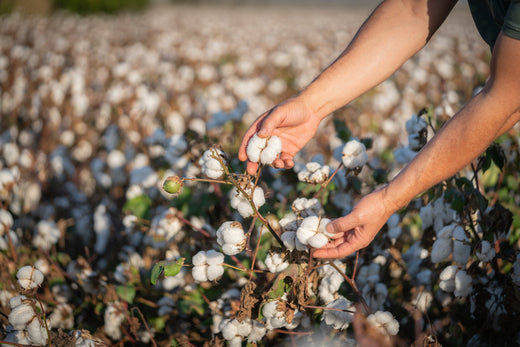
Everything You Need to Know About Organic Cotton Farming
Organic cotton has become a cornerstone of sustainable textiles, offering a safer, eco-friendly alternative to conventional cotton. But what makes organic cotton different, and how does its farming benefit people and the planet? Let’s dive into the world of organic cotton farming to understand its processes, benefits, and challenges.
What Is Organic Cotton?
Organic cotton is grown without synthetic pesticides, fertilisers, or genetically modified organisms (GMOs). Farmers rely on natural techniques like crop rotation, composting, and biological pest control to maintain soil health and ensure a chemical-free crop.
Unlike conventional cotton, which can have a significant environmental footprint, organic cotton is cultivated with sustainability at its core. This makes it a healthier choice for workers, wearers, and the environment.
Shop organic cotton babywear crafted with care.
The Process of Organic Cotton Farming
1. Soil Health and Preparation
Organic cotton farming begins with nurturing the soil. Farmers use compost and organic fertilisers to enrich the land, promoting microbial activity and improving soil structure.
• Crop Rotation: Prevents nutrient depletion by alternating cotton with other crops like legumes or grains.
• No Chemical Additives: Ensures the soil remains free of toxic residues, promoting biodiversity.
2. Water Management
Organic cotton farming uses significantly less water than conventional methods. Techniques like rainwater harvesting and drip irrigation ensure water is used efficiently.
• Fact: Organic cotton can use up to 91% less water compared to non-organic alternatives (source).
3. Natural Pest Control
Instead of synthetic pesticides, organic farmers use biological methods to protect crops. Techniques include:
• Introducing beneficial insects like ladybugs to combat pests.
• Using neem-based sprays, a natural pesticide derived from the neem tree.
4. Harvesting and Processing
Cotton is hand-picked to ensure quality and minimise environmental impact. After harvesting, the cotton is cleaned, carded, and spun into yarn, following strict organic certification protocols.
Benefits of Organic Cotton Farming
1. Better for the Environment
• Reduces greenhouse gas emissions by avoiding synthetic fertilisers.
• Conserves water and protects local ecosystems.
2. Safer for Farmers
• Eliminates exposure to harmful chemicals, improving health and working conditions.
3. Supports Biodiversity
• Crop rotation and natural farming methods promote wildlife and soil fertility.
4. Produces High-Quality Fabric
• Organic cotton is soft, durable, and free of harmful residues, making it perfect for babywear and sensitive skin.
Explore our organic cotton collection for safe and sustainable babywear.
Challenges in Organic Cotton Farming
1. Lower Yields
Organic farming produces less cotton per acre compared to conventional methods, increasing costs.
2. Labour-Intensive Processes
Hand-picking and natural farming techniques require more effort and resources.
3. Certification Costs
Farmers must meet strict standards, such as GOTS (Global Organic Textile Standard), which can be costly and time-consuming to obtain.
Why Organic Cotton Matters
Organic cotton is more than just a fabric—it’s a movement towards sustainability and ethical production. By choosing organic cotton, you support:
• Healthier Farming Communities: Free from harmful chemicals.
• Eco-Friendly Practices: Preserving water, soil, and biodiversity.
• High-Quality Products: Safe for sensitive skin and built to last.
Conclusion
Organic cotton farming is a testament to the power of sustainable practices in creating a better future for the environment and people. While it requires more effort and investment, the benefits far outweigh the challenges, making organic cotton a superior choice for conscious consumers.
Discover our range of organic cotton babywear and make a positive impact today.
